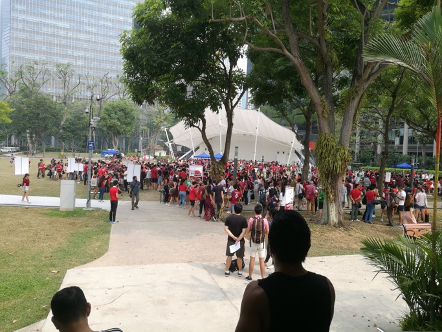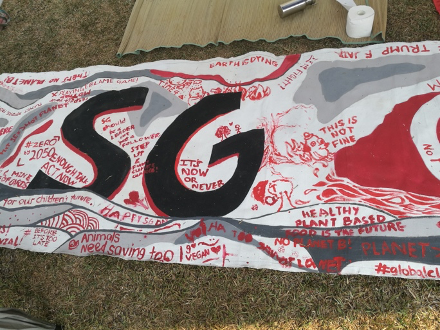Planet Earth is Blue and there’s nothing I can do
Akanksha Raja
(Originally published on apublicsquare.sg - October 2019)
SGRC Signboards. Image courtesy of the author.
It was coming close to 5:30pm on 21 September, the day of the Singapore Climate Rally (SGCR) at Hong Lim Park, and the weather had thankfully allowed for the afternoon’s activities to proceed unhampered. The crowd of about 2000 people—largely youth below the age of 25—had just been listening to a series of speeches about the effects of climate change, given by Singaporeans of various backgrounds and age groups; from a senior professor, to a sustainability professional who is also a young mother, to a number of students—the youngest and arguably most popular being 11-year-old Oliver Chua, who instantly became poster child for the rally and youth environmentalism in Singapore. Before the crowd gathered for the speeches, we were dispersed around the park for various hands-on activities: a group banner-painting, a Kahoot quiz on the climate crisis, small-group information sessions, a platform for communal sharing and discussion of personal climate-related anxieties and grievances.
SGRC at Hong Lim Park on 21 September 2019. Image courtesy of the author.
After the speeches, we began preparing for the guided die-in. As we started with a warm-up of slow silent walking, I caught someone saying, “This is a pure press move.” Certainly, the die-in looked to be the most aesthetic aspect of the event, the focal point for media pictures and videos. If Pink Dot has its light-up, the Climate Rally has its die-in. But beyond the level of optics, the die-in served as a performative representation of the consequences of unmitigated climate change: from marine life suffocating because of plastic litter, to forestry destroyed in mass fires. Movement artist Chloe Chotrani, who led the crowd with gentle but assertive guiding notes, dedicated the die-in to endangered species of tiger, elephant, rhino; dying coral reefs; the oppression of indigenous tribes; the decimated orangutan population in Borneo—a result of deforestation making space for palm oil plantations. Cynics would point out that such a gesture doesn’t benefit any of these populations concretely, and that’s true—it won’t stop forest fires, unbleach coral reefs, or revive populations of wildlife. But as I felt the grass graze the back of my neck and my ears, the meditative process took me, spiritually, out of the concrete jungle—not of the city in itself, but the psychic one that builds in one’s mind, where we are all somewhat conditioned to imagine we’re far away, disconnected from wildlife and sufficiently insulated from such problems.
So I couldn’t help feeling nonplussed and slightly disheartened to see disparaging public responses to the media coverage of the rally. Derision towards an event like Pink Dot sort of makes sense because people do have strong beliefs about the morality of the issue, but reproaching a movement raising awareness about proven environmental issues that impact everyone, seems puzzling.
“Didn’t know there are many artistic actors and actresses in Singapore. Our ‘cultural value’ is belly (sic) high.”
“One day wayang, business as usual come Monday…”
“So many fainted due to the haze…”
“Go Hong Lim Park for a Nap”
Many comments on news articles on the rally seemed to insinuate that attendees were hypocritical in their advocacy for environmental awareness: aren’t they stepping on and killing plants at Hong Lim Park? They most probably drove to the rally in a car and would later go home to turn on their air conditioning on the lowest temperature setting. Other remarks dismissed the Rally as superficial and impractical wayang because it wasn’t a beach clean-up or a tree-planting exercise. In fact, the rally had a detailed Call to Action and held a “Postcard to My MP” session encouraging people to write to their ministers to press for specific policy changes shaped around these calls to action. It does not have the same quantifiable impact as a tree-planting session would, but it is a proactive effort in appealing for long-term change. But of course, less eyeball-grabbing than those “fainting actors” and the impassioned speech of a young boy.
Possible reasons for some of the vitriolic response to the rally have been discussed by Mothership, suggesting climate illiteracy and Singaporeans generally just “not being ready” in their mindsets. The rally took place concurrently with what is known as the Global Climate Strike, in which youths across the world took part in marches and demonstrations lobbying for greater institutional and government action towards mitigating the effects of climate change: action that goes beyond dated campaigns about the 3Rs—after all, individual practices are not as effective in mitigating the climate crisis as changes on policy and institutional level. The SGCR’s objectives were the same: to advocate for systemic change, in a non-confrontational manner. While taking place in conjunction with the global movement, SGCR pointedly disavows the term “protest”, and asserts that the rally is a “distinctly Singaporean experience”. But because Hong Lim Park—to many Singaporeans—is synonymous with the idea of protest, and the danger of “foreign influences”, coupled with the fact that the rally took place amid heated discussions here about whether university students should be learning about dissent, perhaps these factors compounded the hostility towards the SGCR’s efforts. I also wonder if there may be a kind of deeply-entrenched learned helplessness/hopelessness to the possibility of change for a better environment, therefore such efforts appear to be foolish and idealistic rather than reasoned and pragmatic.
Some of the ministers responded to the 418 postcards sent from SGCR, and the Worker’s Party released a statement on the issue. Perhaps the necessary changes may not fall into place soon, but in a country where it often feels like nobody listens, such a response to activist effort is the best we can hope for.




